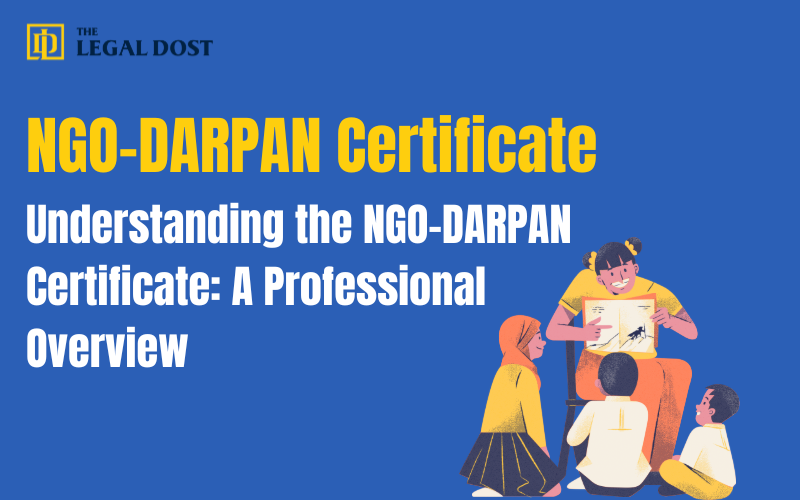In the evolving landscape of non-profit governance and accountability in India, the NGO-DARPAN portal, developed by the NITI Aayog in collaboration with the National Informatics Centre (NIC), plays a crucial role in bringing transparency and credibility to the voluntary sector.
This article provides a comprehensive and professional overview of the NGO-DARPAN certificate, its significance, benefits, registration process, and how to access it.
What is the NGO-DARPAN Certificate?
The NGO-DARPAN certificate is a digital credential issued upon successful registration of an NGO or Voluntary Organization (VO) on the NGO-DARPAN portal. It contains a Unique Identification Number (UIN) that serves as official recognition by NITI Aayog. This certificate is essential for organizations seeking government funding or participating in various development schemes.
Purpose and Importance
The primary aim of the NGO-DARPAN portal is to:
Maintain an authentic and updated database of NGOs/VOs in India
Enable the government to monitor fund disbursements and performance metrics
Promote greater transparency and eliminate fraudulent activities in the voluntary sector
Holding an NGO-DARPAN certificate offers several advantages:
Eligibility for government grants and schemes
Increased visibility and legitimacy in the eyes of donors and stakeholders
Access to FCRA compliance and CSR collaborations
Centralized documentation for smoother regulatory and reporting processes
Who is Eligible to Register?
The following legally registered entities are eligible to obtain an NGO-DARPAN certificate:
Trusts registered under the Indian Trusts Act
Societies registered under the Societies Registration Act
Section 8 companies (non-profit companies registered under the Companies Act)
Required Documents
To complete the registration, the organization must provide:
Certificate of Registration (Trust Deed, Society Certificate, or Certificate of Incorporation)
PAN card of the NGO
Details of at least three members of the executive committee with their PAN and Aadhaar
Address proof of the organization
Objectives and activities of the organization
Financial statements, if available
Step-by-Step Registration Process
Visit the official NGO-DARPAN portal: https://ngodarpan.gov.in
Create an account using the official email and mobile number
Log in and complete the organizational profile, including registration details and purpose
Add information on key functionaries or board members
Upload the required documents in the prescribed formats
Submit the application for verification by the authorities
Upon successful verification, a Unique ID (DARPAN ID) is issued, which can be downloaded as a certificate from the portal.
How to Download the Certificate
Once your organization is verified:
Log in to https://ngodarpan.gov.in
Navigate to “View Profile” or “My NGO Details”
Click the “Download Certificate” option
Save the PDF file for official use
The certificate is valid indefinitely; however, any updates to the organization’s profile may require re-verification and downloading of the updated certificate.
Conclusion
The NGO-DARPAN certificate is more than just a registration formality—it is an essential document that enhances the credibility, operational transparency, and funding eligibility of non-profit organizations in India. By maintaining an updated profile and utilizing this platform, NGOs can streamline their compliance, increase their outreach, and strengthen their engagement with government and donor agencies.
For official registration, visit the NGO-DARPAN portal at:
https://ngodarpan.gov.in
The Reverse Charge Mechanism (RCM) is a tax collection method under GST where the recipient of goods or services, instead of the supplier, is responsible for paying the GST directly to the government.
RCM applies to transactions such as legal services, goods transport agencies (GTA), e-commerce operators for certain transactions, import of services, and purchases from unregistered suppliers.
Yes, businesses can claim ITC on RCM payments. They must first pay the GST liability, report it in GSTR-3B, and then claim ITC in the subsequent eligible return.
Under RCM, businesses must pay GST upfront, which can create short-term cash flow constraints. However, they can later claim ITC to offset this cost.
Businesses must issue self-invoices, pay GST on applicable transactions, report RCM transactions in GSTR-1 and GSTR-3B, and maintain digital records as per updated compliance standards.
Failure to comply with RCM regulations can lead to higher penalties, interest on unpaid tax, and stricter audits as per the revised GST laws in 2025.
Key updates include expanded coverage of digital and gig economy services, automated verification for RCM payments, stricter penalties for non-compliance, and simplified ITC claim processes.


